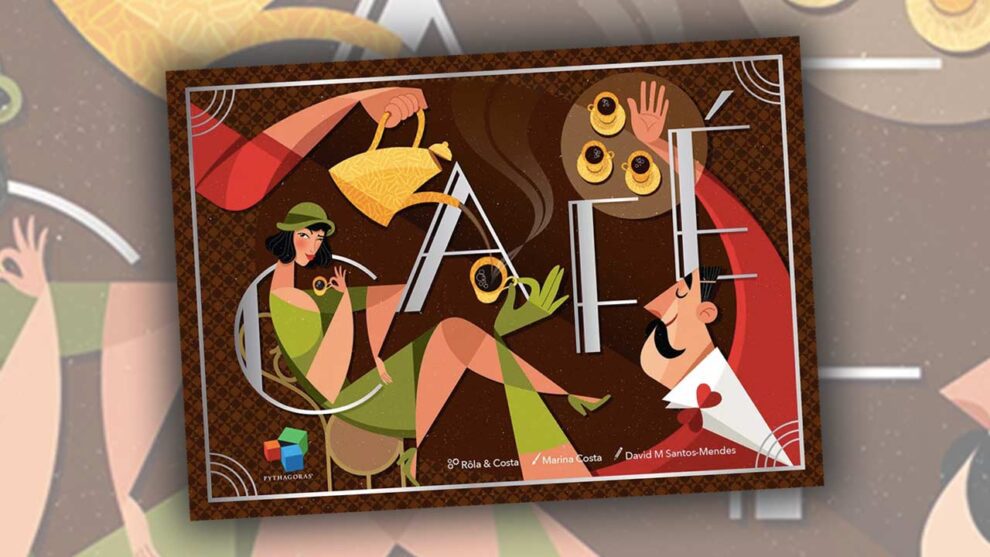Introduction
What exactly is a café? Is it just a place to enjoy the smell of brewing coffee or a mid-morning brunch, or is there something more to these spaces? Observe the workings of a café, and one will see lovers holding hands, parents educating children, deals being struck, research unfolding, assignments taking shape, and lives being made (and undone) simultaneously. Cafés, whether we realise it or not, are places where we commune and share our lives with others—even if we are only focused on our own. Both public and private, they are spaces where activity and reflection coincide, where life can be loud or quiet depending on what is required.
Café, designed by Costa (Luís Costa) and Rôla (José Carlos Santos), with artwork by Marina Costa and published by PYTHAGORAS, is a quiet game. Set in early 20th-century Portugal, during a period when the country was benefiting from the booming coffee trade in Brazil, Café offers a small-box, multiplayer solitaire euro that sees you produce, dry, roast, and deliver coffee beans to historical cafés across the region. Nominated for various awards, including winning the 5 Seasons Portuguese Game of the Year and Best Portuguese Strategy Game in 2020, Café is a 1-4 player, 20-30 minute, light-medium weight game that packs quite an impressive punch, with a theme that wraps richly around its abstract mechanisms, making for a wholesome multiplayer solitaire experience that may not be everyone’s cup of tea—or in this case, coffee.
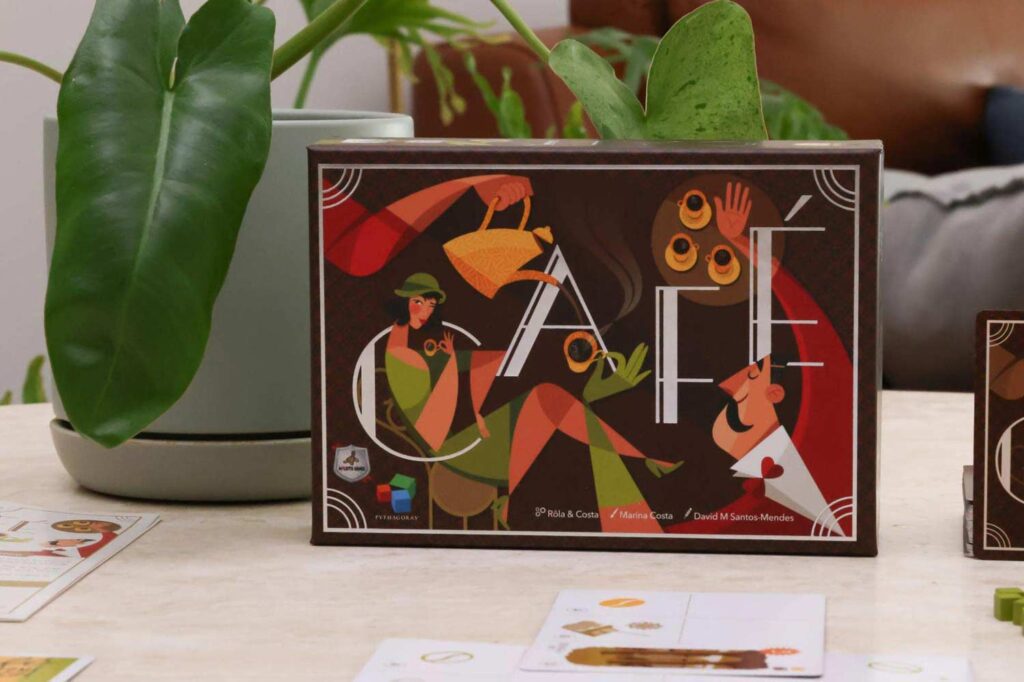
Theme & Gameplay
Before Brazil was known for its coffee plantations, its economy was primarily recognised for gold mining and sugarcane harvesting. However, as more people migrated to the region for wealth and stability, gold became harder to find, and international competitors challenged Brazil’s once-dominant position in sugarcane production. To sustain its economy, a new crop was needed—and it was rumoured that France was guarding a secret that could change Brazil’s future forever.
Coffee had become popular in France, but exporting fertile beans or plants was tightly controlled. So, the Governor of Maranhão hatched a plan and sent one of his best military officers, Francisco de Melo Palheta, to investigate. As the story goes, Palheta used more than just his diplomatic charm—he wooed the wife of one of the French governors, who then gifted him a secret stash of coffee beans and plants hidden in a bouquet of flowers. How true this is, no one knows—but as the story goes, from this scandalous affair, the coffee bean was introduced to Brazil, setting history off in a new direction.
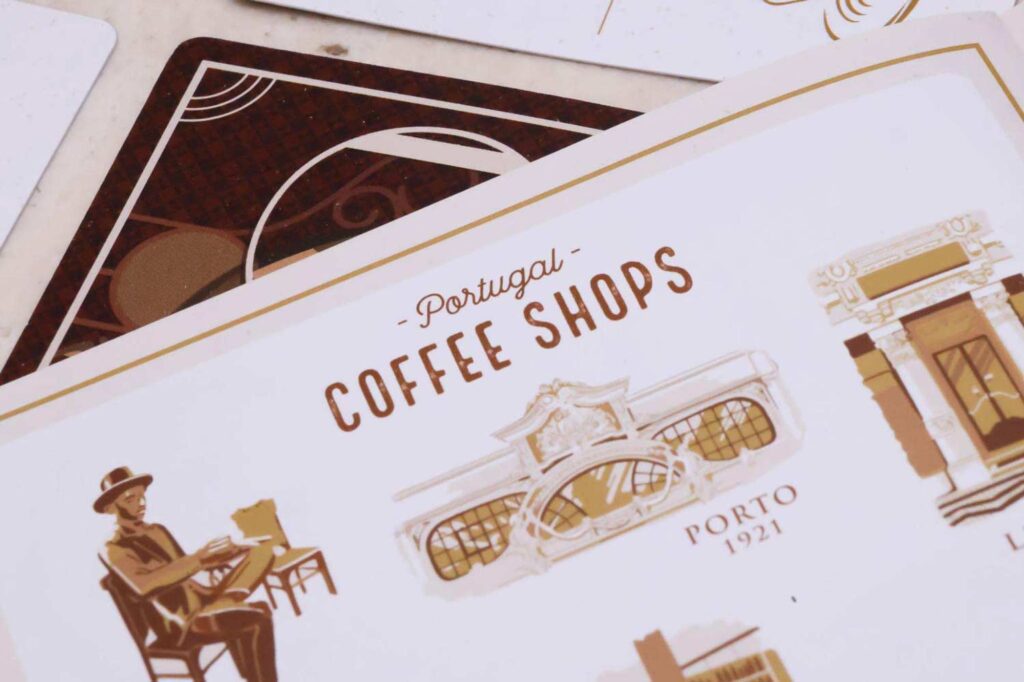
Café sets its theme at a time when European demand for coffee was booming, with Portugal playing a central role. In response, coffee production in South America—particularly in Brazil—began to grow rapidly. Boats would set sail filled with beans from the region, arriving in the bays of Portugal ready for roasting and trade, helping to lay the foundation for what would become one of the world’s most significant coffee industries.
Despite its title, Café doesn’t attempt to recreate the hustle and bustle of a café as English-speaking players might expect. In both Portuguese and French, the word café refers not only to the spaces that serve coffee but also the drink itself. In this instance, Café highlights the often-overlooked work behind the scenes, celebrating the locals who strive to build lives and livelihoods for themselves within various aspects of the coffee industry.
In the game, you’re tasked with managing a roastery, developing an engine that can supply as many cafés with coffee as possible, whilst steadily keeping your warehouse stocked. This plays out abstractly, through drawing and laying cards from a market, covering two or more spaces in your tableau in a puzzle-like fashion to form a large polyomino engine.

Opportunities are won or lost based on the cards available in the market, and hard decisions must be made as each new card forces you to cover up parts of your tableau, sometimes resulting in gains for your business and other times in losses. This introduces a subtle but constant tension to the game, where, like in the industry, you are at the mercy of market forces. Final scores are tallied at the end based on how many cafés you delivered specific beans to, in combination with the two lowest number of beans in your warehouse, making the final round a reflection of your business’s overall productivity.
Artwork & Integration
The artwork for Café, provided by Marina Costa, an illustrator and graphic designer from Lisbon, Portugal, captures the era of the game’s setting in nostalgic, earthy tones. The shades of brown echo the spectrum of a well-drawn espresso, while the greens, reds and yellows are reminiscent of the Portuguese flag. The box art and rulebook draw on Art Nouveau and Art Deco aesthetics —a style synonymous with the setting—with this carrying through to the rulebook and card backs. However, with the playing side, Costa leans into a more realistic style reminiscent of early 20th-century commercial illustration, while the paintings of the cafés and people take on a more fluid, expressive look—something Costa said she intentionally designed to evoke the impression of being drawn from spilled coffee.
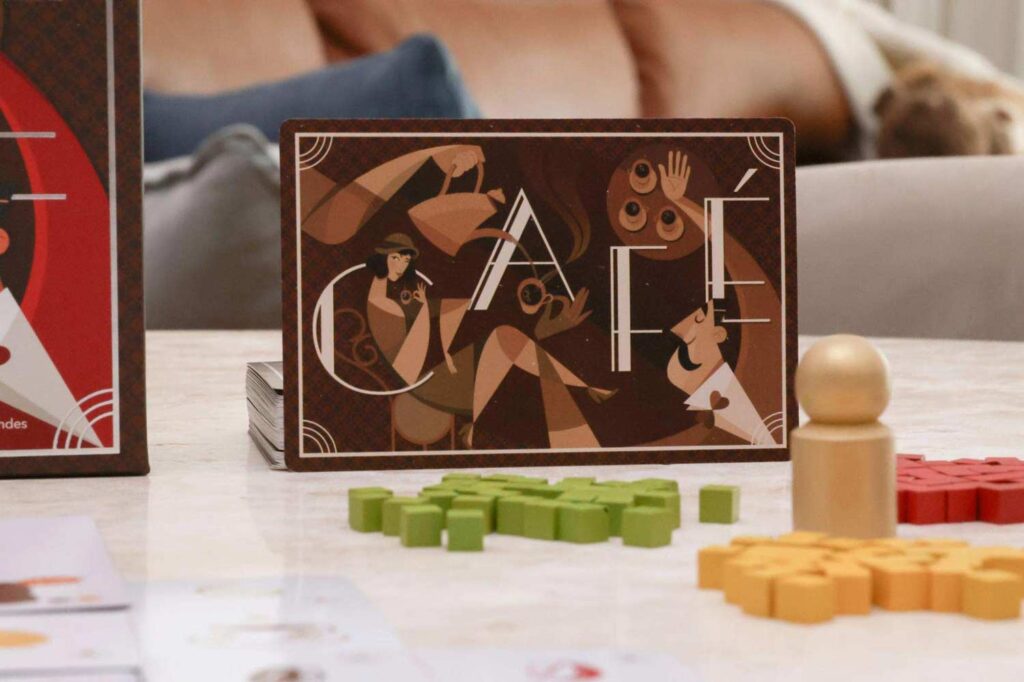
The cards themselves are divided into six equal regions, each featuring a mix of icons—a boat (representing importation), four different coloured beans, drying stations, coffee grinders, coffee cups, empty spaces, and famous cafés from across Portugal. The cafés featured on the cards span from the late 18th to early 20th century, depicting what in real life are some of the most beautiful and culturally significant cafés in the world—for example, the heritage-preserved Café Imperial and A Brasileira. One of the stated visions for PYTHAGORAS is to create titles that are historically rich and educational, and it’s here that Portugal’s café scene stands as the focus of the game’s intention.
Despite this history and storytelling being embedded in the visuals, none of it, however, is spelled out within the game itself. The rulebook offers a brief introduction but the rest is left for players to research for themselves. It’s hard to know why this wasn’t included. Perhaps there were budget constraints. Maybe it wasn’t initially intended for an international audience, and as such, assumes a level of cultural knowledge. Maybe it was only intended for schools, where history teachers can fill the gaps. Or perhaps, being a small-box game, it was simply thought that deeper context wouldn’t be of interest. It’s a shame, as without writing this review, I would never have known the full extent of the significance.
There is, however, another note worth acknowledging: if you scratch too deeply at the history, beneath the hard work of the Portuguese people lies a reality that many may prefer not to face. While the coffee industry brought significant wealth to Portugal and, more broadly, to Europe at large, it was also built on systems of slavery and exploitation—many of which continue in different forms today. So, while Café may appear unassuming on the surface—a charming card game about producing and delivering coffee—the more one digs beneath that surface, the more complex and sobering its story becomes.
Components & Rulebook
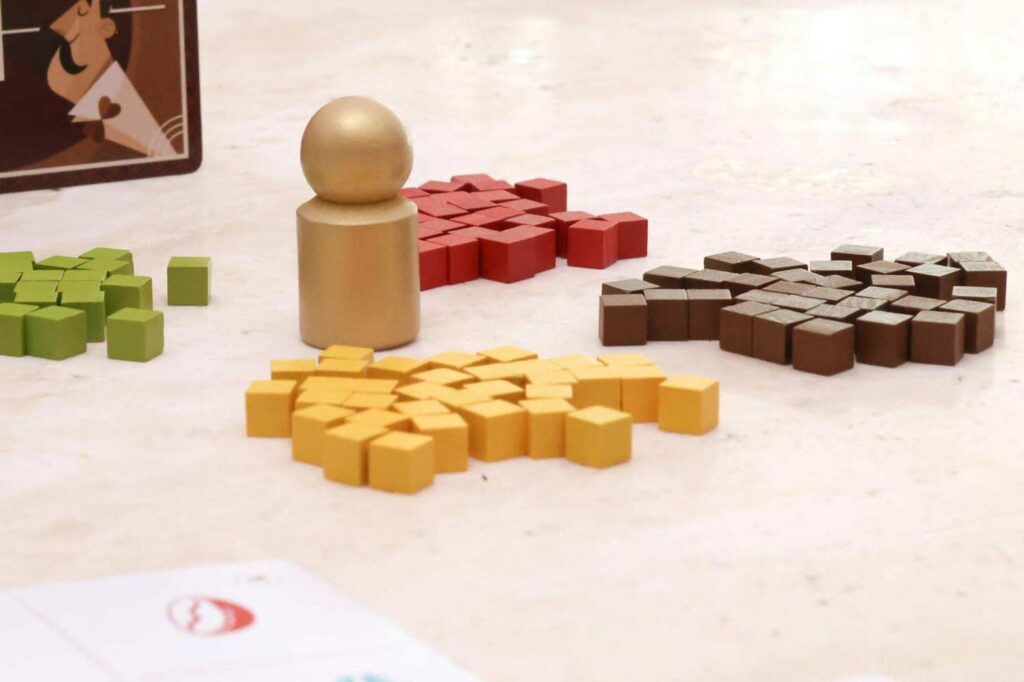
Café aims to be a budget-friendly game, and the components are elegant for their price range. For $22 on the Australian market (approximately $14 USD), the components are solid—but nothing to boast about. The cards are a good size (81x120mm) with a gloss finish, providing enough space to layer them in one’s tableau while still placing beans across the various production phases as part of one’s actions. They do feel a little thin but hold up to regular play. The mini cubes representing the coffee beans are very small, which could be an issue for those with larger or less dexterous hands, and understandable critiques have been made about the muted colouring being difficult for those with colour blindness. This is not to say that anything about Café is poor quality; however, quite the opposite. It’s impressive what they have managed given the price point.
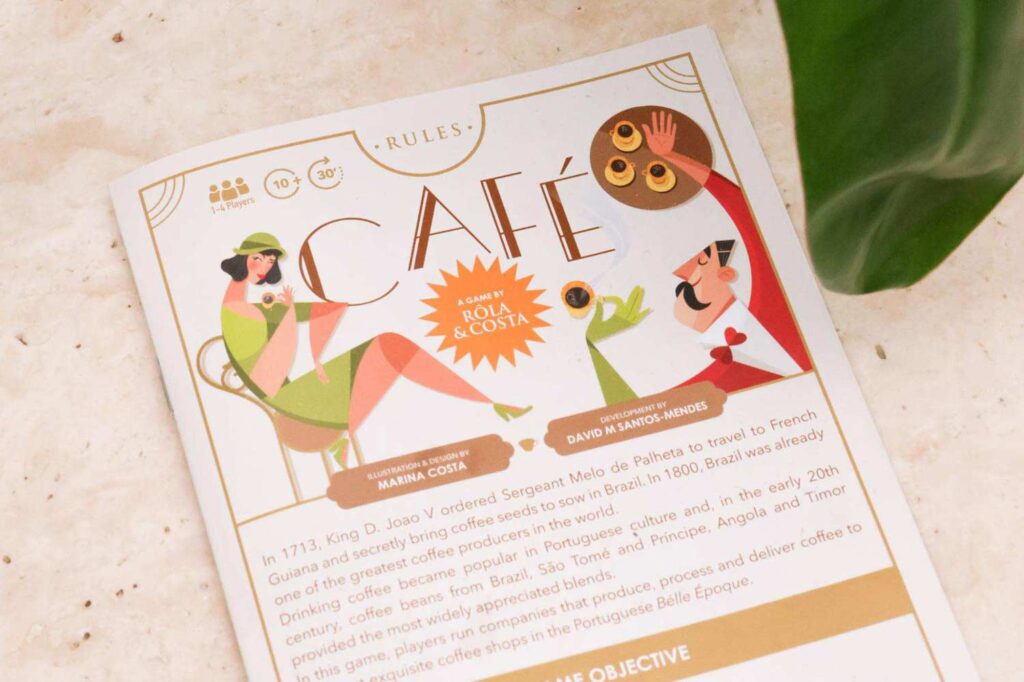
The rulebook is short and sweet and does a good job of communicating the rules and gameplay. There were occasional moments of confusion upon learning, which may have been due to translation from Portuguese into English, but the essence was captured, and we were up and running in no time. There are some issues with the book’s order. For example, we were not aware that the Espresso expansion (spelled as “Expresso” in the game, which I believe aligns with Portuguese usage) was included until we were well into the gameplay. We had to look at the details at the end of the book to understand the additional icons mid-play, not realising they were part of an expansion.
The “general concepts” section also seemed like an add-on, tacked to the back, when they could have been up front, making more sense of the rules that would have followed.
Other than the accessibility note, these other critiques are minor issues and most likely the result of an amalgamation of upgrades, add-ons, translations, and refinement for international printing.
Weight & Balance
I’d place Café as a light-medium euro game because it is quick to teach and not overly complex, but the strategy required to maximise the spatial engine-building puzzle can be deceptive, requiring considered planning, thoughtful layering, and occasional hard choices.

Your engine is built by matching icons orthogonally, with each match enabling you to get the most out of a turn—for example, roasting or drying multiple coloured beans in one action rather than just one per turn. This creates a very real possibility that one poorly placed card can result in a weak engine with little room for recovery across the rounds. This creates a tension when placing your cards, as you aim to maximise efficiency while ensuring you have enough coffee cups for actions, and cafés visible for end-game points.
With only eight rounds in the game, it feels tight, and I am often left wishing for just one more round to execute my final moves. This can be adjusted with house rules (e.g. refreshing or leaving more cards in the market deck), but this tightness is also part of the game’s tension.
A certain amount of luck is involved, with the cards in the market being drawn randomly. Other players may also take the card you were hoping for. Still, these factors are minimal in the game, forming part of the challenge rather than imposing a disadvantage. As the game’s theme suggests, one has to keep adapting to change—just as one would have done in real life when working in the industry. That said, the cards are reasonably well balanced, with enough room to still build and master one’s skill in scoring.
Interactivity & Replayability
When played as intended, players take turns simultaneously, the only interaction being the selection of cards from the market. An advanced variant introduces bidding for market cards, offering a different twist. However, this mechanic feels somewhat tacked on—more like an afterthought than a core feature.
For experienced players, a multiplayer game can be completed in 20–30 minutes. With a teach, expect at least 40-50 minutes, depending on the number of players, familiarity and skill level.
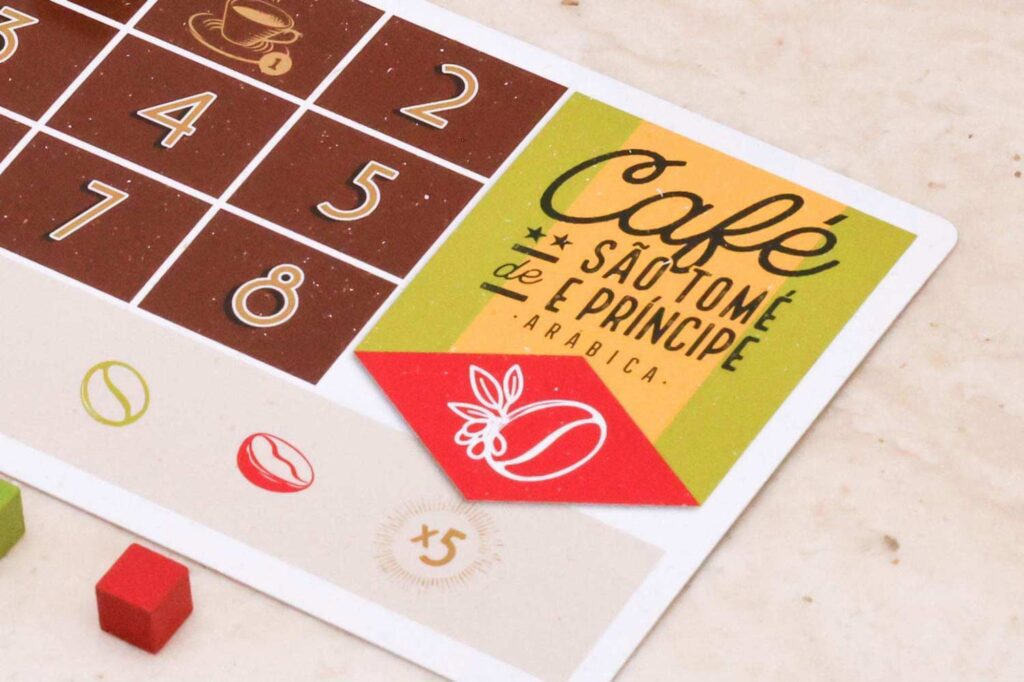
The designers suggest that players talk through their actions individually during the first few rounds, supporting each other to understand the mechanics. Once familiar, the game shifts to simultaneous play. In this mode, downtime is minimal, held up only when players struggle to choose their card. Depending on how you define analysis paralysis, this could be an issue here, but as the options are limited, it wasn’t a problem for us in our games.
I enjoy interaction in my games, so when we played while talking through our turns, I appreciated the chance to connect with my co-player and collaborate on building our engines, which led to higher enjoyment. But once we switched to simultaneous play, the experience shifted into quintessential multiplayer solitaire. I don’t mind multiplayer solitaire in small doses. However, I still like to feel as if we’re playing together to really enjoy the experience. I know others don’t feel the same, so if you enjoy streamlined, no-to-low-interaction games, this one may suit you. But for those who value interaction, it might fall short.
This was the one area where the game fell flat for me. There’s much I admire about Café, and I genuinely think it’s an impressive game given its size and limitations. Still, for me, the desire to replay has been lacking. After a few enjoyable rounds during the learning phase, once we moved into simultaneous play, the game hasn’t seen active table time, as we generally prefer more interactivity. However, I recently brought it out to teach my elderly father—whose favorite card game is solitaire—and he loved it. In this context, it shone: quick to teach, accessible, and satisfying for a new player unfamiliar with euro games. His enjoyment has given Café a renewed lease on life for me.
Solo Play
There’s a reason why Café was nominated for the 5 Seasons Best Solo Mode Award—and it’s not because there was a drought of great solo games in Portugal at the time. In many ways, Café stands stronger as a solo game than a multiplayer one, given, as stated above, that the multiplayer variable is fundamentally multiplayer solitaire at its base.
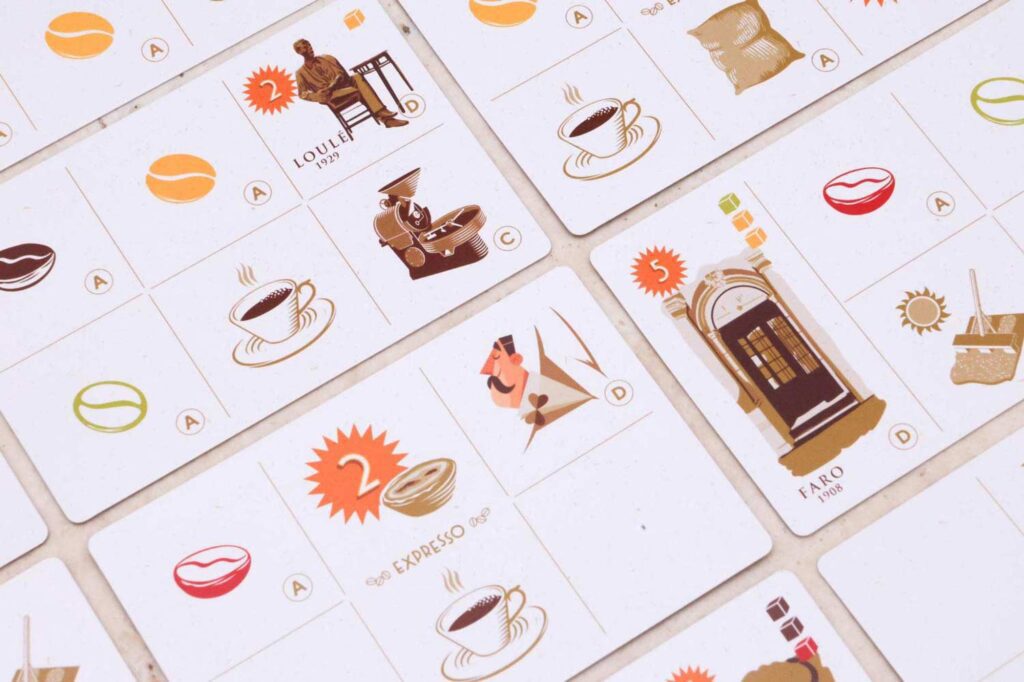
The solo mode uses a beat-your-own-score system, with the publishers releasing a score guide for those interested in refining their skills (published in the rulebook in our version here in Australia, but not in the original prints). It’s not easy to score in the upper realms (36 and above), so for those who enjoy chasing high scores, this presents a genuine challenge.
My experiences playing solo did not differ much from the multiplayer games—which is a testament, in my books, to quality solo game design. I’ve read many solo reviewers share their love for Café, with many noting its calming effect and ease of replayability, thanks to how quickly it plays and how easily it gets to the table. Based on my experiences, I would agree.
Final Thoughts
I have seen some reviewers call Café bland and disappointing; I’ve seen others list it in their Top 40 games of all time. It goes without saying—it’s impossible to please all gamers. What I can say after playing Café is that from the first play until now—even though I prefer more interactive games—I have never once walked away without being impressed with its design. There is something genuinely wholesome about the designers’ intent to celebrate and bring attention to the hard-working people of 20th-century Portugal. The inclusion of the era’s history—although not featured in the game’s text—is still richly present. And even though the mechanics are abstract, there’s enough wrapped around them to make them feel somewhat thematic and interesting.
I genuinely appreciate what the designers have achieved with this game and wanted to write this review in honour of this. I keep saying it because it’s an integral part of why I respect Café: in such a small box, they’ve managed to capture not only a rich history but also thoughtful, fun, and enjoyable gameplay that holds just enough complexity to keep it interesting on multiple plays. I believe that Costa and Rôla, in collaboration with PYTHAGORAS, have done something special here—showing an elegant commitment to what can be achieved in this genre. I love PYTHAGORAS’s aim to make games that can be used as school support tools, with the intent to awaken kids’ creativity and interest in history. I believe, with a little support from a teacher who can fill in the gaps, they have achieved this here.
So, if you’re looking for a quiet moment to step back from the bustle of your day while still wanting to share in the active commune of life, then Café—just like a real café can do—offers a space for exactly that: a thoughtful place to sip your coffee, lay some cards, solve a puzzle or two and enjoy the history you’re part of, unfolding around you.


